Terry’s last post spurred spawned this one. With many editing softwares available, it’s difficult to decide on the one that will work for you. I use ProWritingAid Premium, though like Terry, I take the advice that resonates and ignore what doesn’t. The worst thing a writer can do is to depend on automated software to do all the heavy lifting, or it’ll strip out your voice and style choices. The nice part of ProWritingAid is its ability to learn. The more you use it, the less it flags nit-picky things. You can also tell it not to check for certain things.
For example, I include quotes with some chapter headings as a subtle POV signal to the reader. Only one character has quotes in his chapter headings. Every single time, ProWritingAid flags the quotation marks for not being closed at the end of each line, even if it’s mid-quote. I don’t want to tell the software to ignore the quote rule or it won’t catch places in the narrative where I may have forgotten the end quote. See what I’m sayin’? Be careful of which rules you set to ignore. You may need that second pair of eyes later.
Whether you use the free or paid version, the first step is to download the software (available for Mac or PC). Once the software downloads directly into MS Word, it’ll add a new button to the top ribbon. Also available for Google Docs, Scrivener (desktop), or as an extension for Chrome, Firefox, Safari, or Edge.
Here’s what it looks like in Word.
(click to enlarge)
When you want to use the software, click the button. Easy peasy. If you don’t want to download the software, you can use the app instead, which opens in a new tab/window. In the app, you’ll have to upload a doc. When downloaded to Word, the software will read whatever document you’re in.
Once you open the software, click the dropdown menu. Since I write thrillers, I keep it set to Thriller, but you can choose any genre of fiction, formal or business writing, other nonfiction, or even email.
After PWA processes the document, it’ll show you suggestions for improvement.
Because I’m using the software as I write this post, it’s showing suggestions for all of it. LOL
If I click the first suggestion, it looks like this…
The program didn’t like the spaces between ProWritingAid, so I accepted the revision by clicking the highlighted suggestion. Boom — it corrected the spelling for me. The next suggestion was “nice” in the opening paragraph of this post. I clicked “ignore,” but check out the alternatives…
(click to enlarge)
Let’s move on to fiction… For this post, I pasted a few paragraphs from the WIP. Keep in mind, I’m in the drafting stage. 😉
A gunshot coiled through the dark forest, and he ducked, the bullet sailing over him. Not that I could pinpoint something that small, but it sure didn’t hit him. Before the scumbag had time to fire a second shot, Mr. Mayhem dove on top of him, tackling him, wrestling in the dirt, arms, legs, and fists flailing.
My breath stalled somewhere in my chest. Where’s the third guy?
Through the binoculars, I scanned left.
The software suggested I add “the” before “left,” but it reads fine without it. If my editor suggests the same, then maybe I’ll change it.
No beam of light. I swung the binoculars to the right. No light-beams. Where the hell did he go? Once I lowered the binoculars, my blood turned to slush. Camouflage boots clomped through thick underbrush—twenty feet from the oak tree!—a sawed-off shotgun rested on linebacker shoulders. Behind him, Poe emerged, divebombing the intruder, crow feet stomping on his head.
PWA caught the missing hyphen in dive-bombing. I accepted the change by clicking the green highlighted area. (click to enlarge)
The mobbing technique allowed me enough time to climb down, Shicheii’s quiver slung on my back, his bow held tight in my hand.
Shicheii means maternal grandfather in Diné, so I added his name to dictionary like this..
(click to enlarge)
At fifteen feet away, I stopped, reached behind me, and slid out an arrow. Aimed low to avoid Poe. Fired. The razor-tipped arrow sailed through the air, striking the scumbag in the thigh.
Shoot. Missed my mark.
I reloaded. Aimed a scooch higher. And fired. This time, the arrow zipped right past him, missing his hip by an inch, maybe two.
Since scooch is a word, and it’s spelled correctly, I added it to dictionary.
“Screw this.” I dropped the bow, squirmed my arms out of the quiver straps, and charged straight at him, bellowing a deep, raspy roar, my voice coiling through the trees, boomeranging right back as I lunged at him.
Arms spread like wings, I flew through the air without considering the consequences. If he raised that shotgun, he could kill me. Didn’t matter. Everything within me screamed for me to protect my family, and sheer animalistic instinct took over. I landed on his chest, and we both tumbled backward.
I ignored the suggestion to remove “through the air” after “flew” because it doesn’t sound right to my ear.
Here’s where you need to be careful. Don’t accept that the software knows better than you. Since this is an early draft, I’ll probably end up rewriting the sentence to use swan-dive instead of flew (paints a better picture), but that’s irrelevant. The point is, question every change to remain true to your voice, your style.
While straddling his hips, I threw a mean right hook, sucker-punched him—almost broke my friggin’ knuckles on his blocky nose—and I swear he laughed. Over and over, I hammered his face in rapid succession, first the right, then left, alternating between the two to keep him off-balance.
“Who’s laughing now, asshole?”
Probably shouldn’t’ve gotten cocky, because he muscled me onto my back. Drilled me in the right temple with his fist, and tiny specks of bright, white light danced before my eyes. That only pissed me off more, and I chomped down on his forearm, my teeth sinking into his flesh.
Valid suggestion, PWA. The comma is unnecessary after “bright.”
<– At the bottom of that pane, it says Open Full Editor.
When I click that button, it opens in a new window.
(click to enlarge)
Notice the side column. I’ll scroll through for you…
Everything looks good, except dialogue tags. But I don’t have any dialogue tags in the excerpt. Hmm, let’s see what it says by clicking the dialogue box in the top-right corner.
Okay, it’s just explaining why “said” and “asked” are best to use. Not sure why it says 100% in the negative. There are no dialogue tags. Perhaps that’s why. See what I mean about not blindly trusting editing software? You—the writer—need to weigh each suggestion. If it works, accept the change. If it doesn’t, ignore and move on. Your human editor should flag it again if there’s a problem.
Now, if you’re just beginning your writing journey, click each dialogue box for a full explanation of why to remove things like weak adverbs from your writing.
Here’s what it says under “Weak Adverbs”:
(click to enlarge)
Check out the top ribbon of the full editor. You can tell the software to search for anything. Overused Words, anyone? We’re all guilty of littering the first draft with crutch words.
(click to enlarge)
Check out the Thesaurus. Not only does it tell you how many nouns, verbs, adjectives, and adverbs the document has, but look at all the suggestions it offers for the word “different”.
(click to enlarge)
This software checks for everything, from sticky sentences, homonyms, echoes, and alliterations, to structure, pacing, and a visual representation of sentence length. Seriously, you could spend hours dissecting your prose. I don’t, but if you’re just learning the craft of writing, spending time learning the basics is time well-spent. I love ProWritingAid Premium because it catches typos, commas, grammatical errors, awkward sentences and/or phrases, or clunky words written when your soul’s on fire and your fingers are sailing across the keyboard. You know what I’m talkin’ about, that sheer passionate writing that made so much sense in the moment, but in the cold light of day, needs tweaking.
Let’s talk about money for a minute. I pay yearly, but they also have monthly plans. I buy yearly plans at Christmastime, because it’s, like, $60 compared to $120 ($10/mo). Or try the free version first. There are some limitations to the free plan. You can only upload five or six chapters at a time, rather than uploading an entire 90K word novel, and you won’t have access to everything in the Full Editor ribbon. But at least it’ll give you the feel of how it works. I’ve used Grammarly, too, and ProWritingAid offers a lot more bang for your buck, IMO.
So, that’s a sampling of ProWritingAid Premium. Hope you found it useful! Do you use editing software? If so, which one?


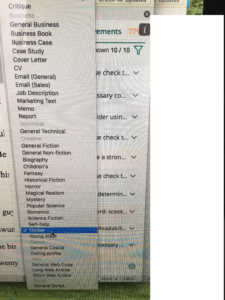
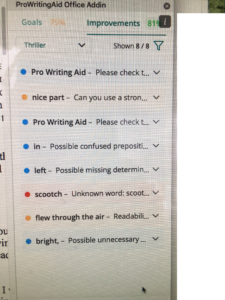
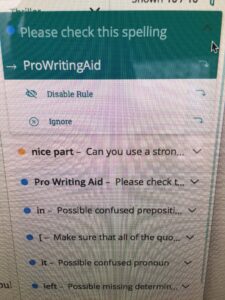
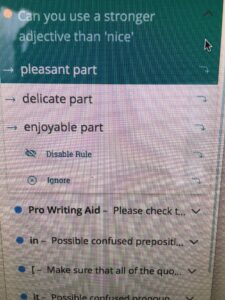
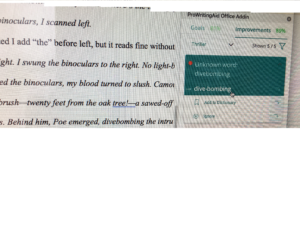
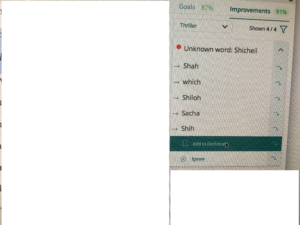
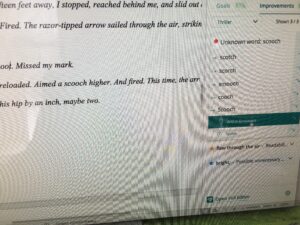
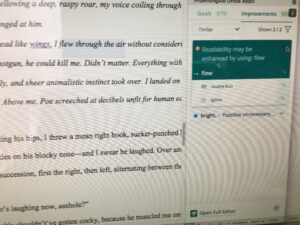
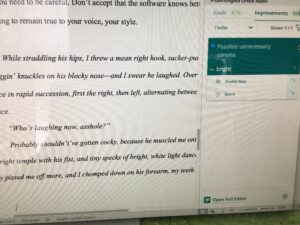
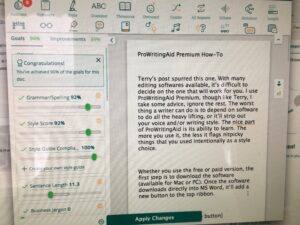
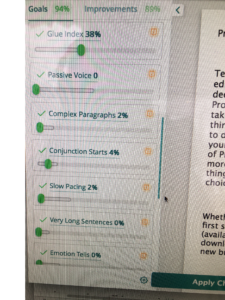
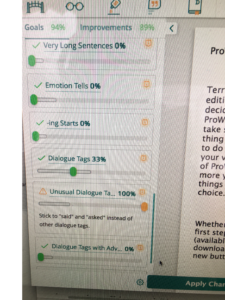
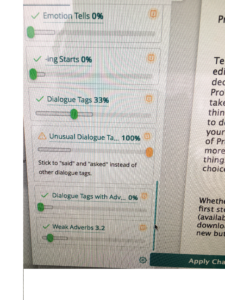
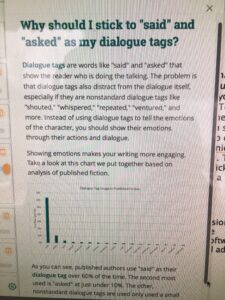
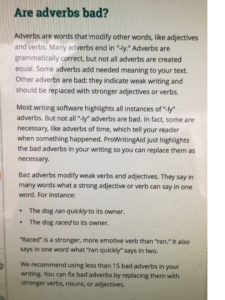
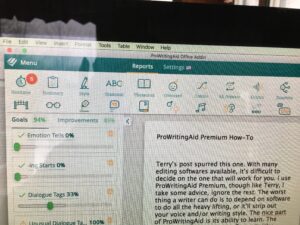
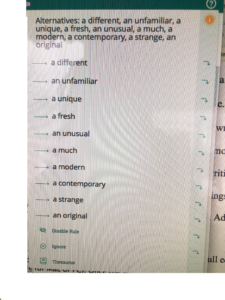
Thanks for the comprehensive overview, Sue. I’m editing the first draft of my WIP so this comes at a good time. Sounds helpful to catch overused crutch words.
The only editing software I ever tried was way back in the Windows 3.1 era. Can’t remember the name but it was mostly a primitive grammar checker. It kept “correcting” dialogue to proper business usage. Annoying as hell so I quit using it.
A silly side note: b/c of computer problems, I’ve been switching back and forth between the Word version in Office 2016 on my PC and 365 on my Mac. The internal editors in the two versions often disagree with each other. Example: “His duffel was full of cash[,] but he felt so weak he could hardly lift the seventy-plus pounds.” One wants to insert commas before “but” while the other wants to delete them. Go figure.
As you wisely say, “I take the advice that resonates and ignore what doesn’t.”
Debbie, the same thing happens if you run a doc edited in PWA through Grammarly. It strips out the commas. Crazy! You’d think they would have the same punctuation rules loaded. Oy.
As a longtime user of ProWritingAid Premium, your overview and advice capture the essence of this excellent writing tool. It has limits, but the benefits far outweigh the shortcomings. I also like that PWA’s browser extension checks as I type this comment, saving me from embarrassing typos, all too common with my fat fingers.
Agreed, Grant. The benefits far exceed the shortcomings. I could’ve included a lot more, but at some point, I had to stop before the post grew into a mini-course. LOL
I haven’t used anything besides Word’s own features thus far, so it’s good to know the pros & cons of other programs. Thanks.
My pleasure, Brenda! Word’s editing feature is more primitive than PWA, IMO, but it comes in handy while drafting. 🙂
Thanks for this, Sue. I downloaded the free version and snipped a few chapters of the current WIP to see what it did. It would only look at the first 500 words in the free version, so it wasn’t a valid comparison with Grammarly or Word’s Editor. PWA doesn’t know what a jerry can is, either! 🙂
I’ll give it further consideration once I get into my next novel. I still wouldn’t use any of these software options to replace my critique partners and my human editor, though. They know story
Precisely, Terry. Automated editors should never replace human editors, critique partners, etc.
Wow. Only 500 words? That’s changed. When I had the free plan, I could upload five or six chapters at a time.
Still can online.
I’ll have to go back and figure out how to do that. I’m using the online version as far as I know.
Sue, I use the free version online. I put my previous day’s work in there primarily to look for typos and missing words. It often suggests I put in a comma where I want to keep the momentum of the sentence going, so I will ignore that advice. Other times a comma makes sense. It also alerts me on passive voice, which is helpful.
The main thing is to know how you want your prose to sound so you can make informed decisions.
Agreed, Jim. Editing software doesn’t understand sentence rhythm and cadence.
Thanks for an excellent review, Sue! I’ll give the free version a try. I’ve only used Grammarly, and it seems to have the rule that if Word puts in a comma, they will take it out.
I agree with your statement above, “Editing software doesn’t understand sentence rhythm and cadence.” And that’s where text-to-speech becomes one of the most valuable parts of the editing process.
Have a wonderful week!
Haha. So true about Grammarly!
Wishing you a wonderful week, my friend!
Great explanation of ProWritingAid, Sue! I also use it, but you’ve reminded me I should be checking each chapter rather than waiting until I’m done with a complete draft.
In addition to the grammar features, I like the summary report that shows a histogram of sentence length. It’s like seeing the melody of the prose without the words. 🙂
It’s cool, right? A writer could spend hours in all the features. 🙂 Use what works for you and ignore the rest.
Thanks for the overview. You’ve convinced me to try it before I submit my manuscript next week. I’ll let you know how it worked for me.
Fabulous, Patricia! You’ll be amazed by what it finds. Now, I run all my manuscripts through the software before I submit. Saves my editor a ton of time!
I don’t use any editing software beside spell check to make the rudimentary check that I didn’t leave out ‘ in word or anything.
I like relying on my own editing skills, and my own sense of rhythm. Sounds uppity, but that’s just the way it is.
One of my professors suggested editing a piece backward, sentence by sentence, so you focus on the grammar and not get caught up in the flow. I like doing that.
Cool. I’ve never heard of editing backward, Azali. Maybe I’ll try it. Thanks. 🙂
I have lifetime subscriptions to both ProWritingAid and Autocrit. I tried Grammarly but found it much less useful. Both ProWritingAid and Autocrit are helpful for the self editing stage. As others have said, I would never replace the human editor. I found Autocrit a little easier to learn, but ProWritingAid has more features. What I especially like about ProWritingAid is that I can upload and have it analyze the entire manuscript. That isn’t possible with Autocrit. I suggest writers try the free versions of both, and then pick the one that works best for them. Also factor in price and specials which both offer from time to time. (I got my lifetime subscriptions for both through special one-time payment offers.)
I like the full manuscript feature in ProWritingAid Premium, too, Katherine. Makes things super easy. I’ve never tried Autocrit, but others seem to like it. What works for one writer may not work for another.
Yes, I agree. Editing software should never replace human editors or the writer’s story sensibilities.
This is a fantastic rundown on ProWritingAid, Sue! You presented a mini-workshop in today’s post, with a lot of handy examples. I also use ProWritingAid, the paid version, in App form on my Mac, and provided some great additional tips. I’d been using it in basic fashion, to catch grammar and style issues.
I haven’t tried installing it to Word. I’m using Microsoft 365’s Word, so I’m not sure if I can use PWA as a plug-in or not. I don’t see the genre drop-down in the App version, and that would be reason enough to see if I can.
I don’t see it as a substitute for a human editor, but as an handy aid.
Thanks so much for giving us this instructive gift this morning!.Have a wonderful week!
Dale, Word in Microsoft 365 is exactly what you need. I’m sure they probably have downloads for earlier versions, but I use the 365 for Mac, too. Any other Apple devices will sync, so you don’t need to reinstall the software for your MacBook or iPad. Wherever you’re signed into 365, you’ll have PWA in Word. For a long time, I only used the online version. Downloading to Word made life so much easier.
My pleasure! Wishing you a fab week, as well. 🙂
Great overview (with examples), Sue. I’m adding to my next-book-self-editing-stage notes.
Fabulous, Harald! So glad you found it useful.
Sounds nice, but a bit pricey. In our weekly workshop, one day I pointed out a significant glitch in Tom M’s penultimate chapter, one that affected his entire m/s. “Why are you telling me this NOW!?” he grumbled. A very good question.
The entire workshop had overlooked his mammoth, pervasive plot hole. Why? We were editing at the nit-pick level, a marsha-marsha here, a word-choice there, or (oh horror!) a dangling participle, all the stuff that PWA, et al, do so well.
From time to time, Screenwriting U gives a course in script revision, where you work your way up a pyramid, starting not with Page One, but with the underlying theme/plot/story, going upward thru character, and setting, etc., and finally, the actual text. [Yes, there are two dozen versions of this on the Internerd. Some put theme at the bottom; others, near the top. Some put character at the base.] Revising upward this way prevents perfecting huge blocks of text that you’ll be deleting later.
But it’s best not to write them in the first place. Paula R. and I formed a second workshop, which she named “Vision & Revision,” based on this concept. We read our outlines, loglines, synopses, & concepts in the first weeks, working our way up to text critique, Beta reads, and, finally, outside editing. Paula passed on, and Covid ended V&R. But the principle lives on.
Totally agree with this process, J. Only after the big stuff — structure, plot, theme, story — should we look at nitpicky stuff like word choice, etc.
Or you can do both and keep an eye on both the nitpicky stuff like word choice and the structural stuff. Absolutely ignoring structural stuff is a bad idea, but I find poor word choice impossible to ignore, a bit like a mosquito bite. Putting something on that itch does not mean ignoring it if my poor novel is also having a heart attack.